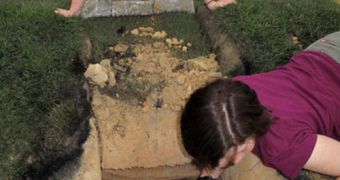Many centuries ago, the borders of the Roman Empire were spread out all the way to Britain, and a permanent garrison was stationed there at all times, to prevent attacks. During their stay, the soldiers made huge numbers of pots, and experts now believe they know how.
The fighters were stationed alongside Hadrian's Wall, a defensive construction built to keep raids from tribes in check. The areas bordering the Wall's former location are filled with pottery shards, that archaeologists keep digging up.
But experts have been wondering for a very long time about how the Romans were capable of producing such large amounts of pottery. An effort to replicate the instruments used has recently concluded at Stanford University, and the work provides more insight into the past.
Stanford ceramic geoarchaeology research fellow Melissa Chatfield is a renowned leader in such replication efforts. She and her assistants built a faithful replica of a pottery oven known as a kiln right on the university campus, behind the Stanford Community Farm building.
A 12-foot-square wooden box was covered by a 5-foot-high grass mound, and a large number of pots were placed within. The whole thing was then set on fire, and left to burn for hours.
This type of construction is a faithful replica of ancient kilns dug up in England, which have been dated to the first century BC. Other kilns, this time created by the Romans a little later on, also served as source of inspiration for designing the new structure.
It took Chatfield and her crew nearly six weeks to construct the kiln. In the end, the pottery oven had a capacity of 40 pots at a time. In order to make it work, the oven was isolated on the inside by using granite cobbles.
“We learn loads from observing how clays respond to heat, things that modern ceramics studies has bypassed on its way to high-fired materials,” Chatfield explains of monitoring the kiln fire.
“What we've learned from the suite of replication events on campus is that the firing technologies evolved to fit the materials,” the expert goes on to say. She adds that the team wants to answer some burning questions about the state of pottery in England before the Roman invasion of 43 AD.
Shards found from before that time show an emphasis on utilitarianism and strength. A lot of mugs were found at various dig sites, and very few of them are adorned. Most are designed to simply fulfill their function, and the experts want to known why.
It could be that this was a practical thing, or that it took less material to make them this way. Or maybe it was cheaper and faster to create bulkier pots. The replication effort is bound to get to the bottom of this, the Stanford expert concludes.

 14 DAY TRIAL //
14 DAY TRIAL //